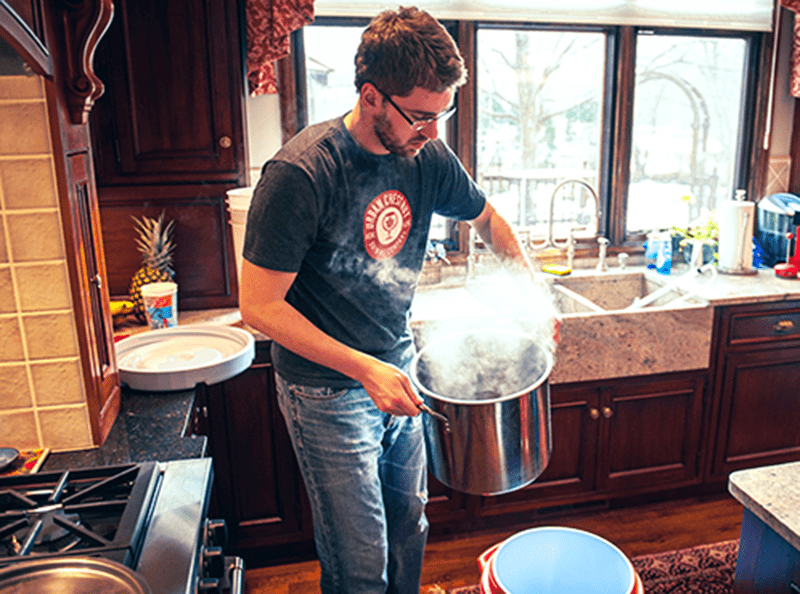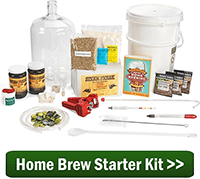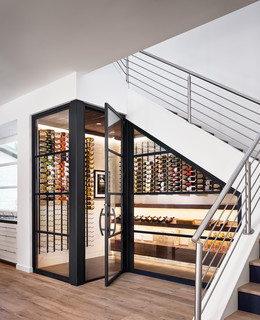 So you’ve just started homebrewing. Congrats! Now, what should you brew? With a seemingly endless list of possible beers to brew, where do you start? What homebrewing ingredients should you get?
So you’ve just started homebrewing. Congrats! Now, what should you brew? With a seemingly endless list of possible beers to brew, where do you start? What homebrewing ingredients should you get?
Here are some easy beer recipes for beginners. These are some of the best, basic homebrewing recipes:
- Hefeweizen – The German-style wheat beer is often a “gateway beer” for beginning brewers. The traditional weizen yeast strain produces flavors of banana and clove. Want more clove? Keep the fermentation on the cool side. More banana? Let the fermentation temperature push to the upper end of the acceptable range, about 64-75˚F. Either way, this is a beer style that’s a great companion to warm weather, goat cheese, and citrus-flavored foods.
- Brown Ale – Brown ale can be a great middle-of-the-road homebrew to enjoy year-round. It’s a malty brew, but the hop character can
 vary depending on your taste. American brown ales tend to have more hop flavor and aroma than English brown ales. Try a nut brown ale to highlight the nutty flavors of some specialty malts. Of these beer recipes for beginners, this one is my favorite.
vary depending on your taste. American brown ales tend to have more hop flavor and aroma than English brown ales. Try a nut brown ale to highlight the nutty flavors of some specialty malts. Of these beer recipes for beginners, this one is my favorite.
- Stout – Stout may be the most forgiving of beer styles, due in part to the roasty malt flavors and dark color that come the use of from chocolate malt, black malt, and roasted barley. This means most stouts are easy beer recipes for beginners. These attributes can also come from dark liquid malt extract or dark dry malt extract. Depending on your tastes, you can brew a dry stout, sweet stout, imperial stout, tropical stout, or even a chocolate milk stout. Whatever you do, be sure to have some Irish stout on hand for St. Patty’s Day!
- Kölsch – Kölsch is a great option for the homebrewer who enjoys a lighter, more delicate beer. It’s about the closest thing to a light lager while still being an ale, featuring a clear, golden color, a respectably prominent hop flavor, and a crisp, dry finish. When brewing a German Kölsch, just make sure you can maintain control of fermentation temperatures from about 60˚F on down to about 40˚F for an authentic character. Here’s some more tips on brewing a Kölsch.
- Chipotle Porter – All beginning brewers reach a point
 where they want to branch out and experiment. If you like spicy foods, then this beer recipe is a great option. Just take a smoked porter recipe kit and add a small can of rinsed chipotle peppers to the boil. If the beer turns out too hot, just give it some time to age.
where they want to branch out and experiment. If you like spicy foods, then this beer recipe is a great option. Just take a smoked porter recipe kit and add a small can of rinsed chipotle peppers to the boil. If the beer turns out too hot, just give it some time to age.
If you’re still not sure what to make, on our website we have a list of some of the best basic beer recipes for beginners. They list all the homebrewing ingredients.
Do you have an easy beer recipe that would be good for first-timers? Please share it below.
—–
David Ackley is a beer writer, brewer, and self-described “craft beer crusader.” He holds a General Certificate in Brewing from the Institute of Brewing and Distilling and is founder of the Local Beer Blog.






 I really enjoy your website with all of the winemaking information. You’re truly educating the winemaking public. My question is, I’m storing my
I really enjoy your website with all of the winemaking information. You’re truly educating the winemaking public. My question is, I’m storing my  Do you have a wine making or beer brewing question that you’d like some expert help with? Ask your question below, and we will feature your question (with the answer) on our blog!
Do you have a wine making or beer brewing question that you’d like some expert help with? Ask your question below, and we will feature your question (with the answer) on our blog!